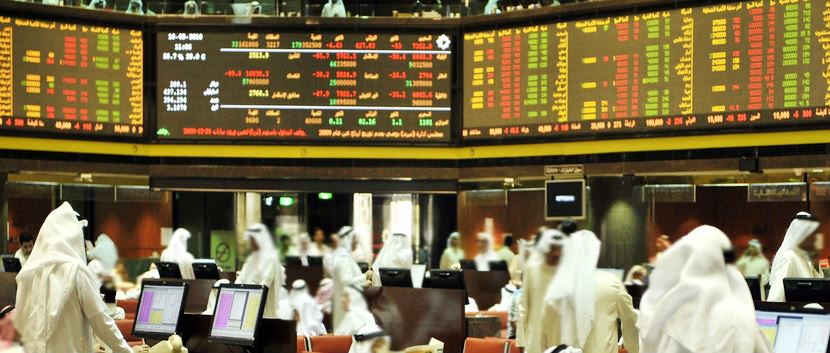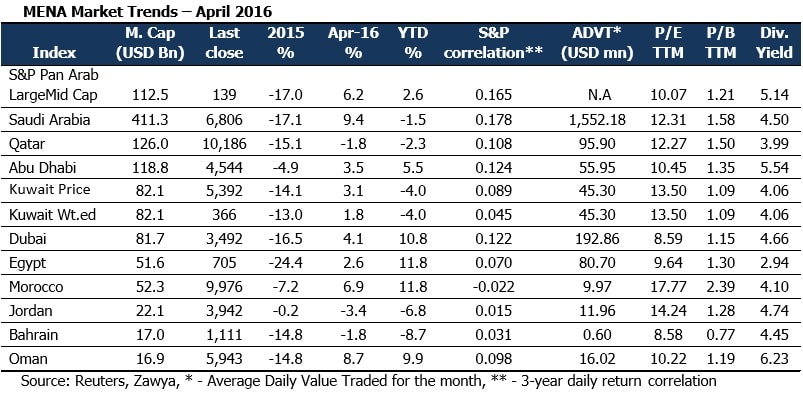
According to Marmore's recently released Monthly Market Review, April was a positive month for all MENA indices, barring Bahrain, Qatar and Jordon, as oil rise buoyed markets. Saudi Arabia (9.4%) was the star performer, followed by Oman (8.7%) and Morocco (6.9%), while Kuwait price and weighted indices rose 3.1% and 1.8%, respectively, in April. Jordan was the worst performer in the month of April, registering a fall of 3.4%. Brent crude rose to its highest monthly gain in seven years, climbing 21.5% to close the month at USD 48.13 per barrel. S&P GCC also improved by 5.7% in March, to close at 95 points.

Gulf markets have been gaining for the past couple of months, on the back of strong oil market performance, with the belief that the oil price movements have turned a corner. Investor focus has now shifted to the corporate earnings that are affected by the austerity measures, which were undertaken due to low oil prices. The TASI index performance was largely due to companies beating their first-quarter earnings estimates, as well as the surge in oil prices. The combined net profits of Qatar's publicly traded firms stood at QR10.8bn for the first quarter of 2016, down 18.9% over 1Q15. Real Estate and Industries sectors led the rout falling by 62.5% and 18.6%, respectively.
MENA markets liquidity had a negative month, with volumes decreasing by 11% and value traded falling by 5.1%. Oman and Kuwait witnessed increases in both volume and value traded, whereas the rest of the markets recorded declines in both. Volume and value traded in Oman increased by 61% and 42%, as investors responded to positive earnings season and rise in oil prices.
Most Blue Chips ended the month of April in green, with Al Rajhi Bank (Saudi Arabia) topping the charts at 16.4%, as the company witnessed a 33% increase in quarterly earnings, mainly due to higher fee income. SABIC (KSA, 13.7%) and Emaar Properties (UAE, 13%) followed, as the former benefitted from rise in oil price, while the latter reported a 17% rise in earnings, despite weakening market conditions. Leading UAE banks witnessed large earnings decline in the first quarter, and most, with the exception of a few, reported rising pressures on key performance indicators such as loans and deposit growth, and asset quality in their first quarter results. Abu Dhabi Commercial Bank (earnings, -18%), National Bank of Abu Dhabi (-11%), Commercial Bank of Dubai (-18%) were some of the big names on the list. ADCB and CBD witnessed a fall in operating income, because of drop in business volumes, while NBAD’s incomes reflected lower investment gains and higher provisions.
Global Oil News
OPEC and non-OPEC producers failed to reach a deal to freeze oil output at the Doha meeting in April, as OPEC members requested for more time to reach a deal among themselves, possibly at a June meeting, before striking one with other country producers.
Kuwaiti oil and gas workers have ended a three-day strike that had temporarily cut the OPEC member's crude production by nearly half. The strike forced Kuwait Oil Company (KOC) to cut output to as little as 1.1 million barrels per day (bpd), down from a normal level of about 3 million bpd, as workers fear reduced salaries, benefits and staff layoffs will be part of a planned government overhaul of the payroll system in the public sector.
According to Reuters, OPEC's oil output rose in April to close to the highest level in recent history, as production increases led by Iran and Iraq more than offset the strike in Kuwait and other disruptions. The region’s top exporter, Saudi Arabia, made no major change to its output, despite the kingdom hinting it could boost supply after OPEC and non-member nations failed to reach an agreement earlier in the month.
Despite the recent rally, oil markets remain oversupplied by about 1-2 million barrels of crude per day, which has led to global storage tanks filled to their rims with unsold fuel.
Oil Market Review
Brent crude hit a high of USD 48 per barrel in the month of April, up 21.5% from March, the best monthly gain seen since May 2009. Weaker dollar and positive sentiment about the global supply glut easing raised crude oil futures by more than USD 20 per barrel, since witnessing 12 year lows of below USD 30 per barrel, in the first quarter. Oil price rose, despite OPEC and non-OPEC producers failing to reach a deal to freeze oil output. Members informed non-OPEC producers that they need to first reach a deal within OPEC, possibly at the upcoming June meeting, before being able to invite other producers to join the accord.

